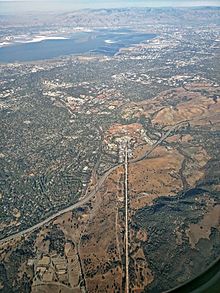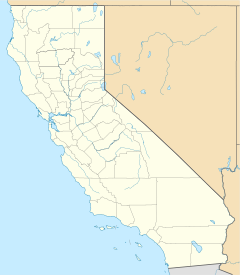
Back مركز المعجل الخطي ستانفورد Arabic স্ল্যাক ন্যাশনাল অ্যাক্সেলারেটর ল্যাবরেটরি Bengali/Bangla Laboratori Nacional Accelerador SLAC Catalan Národní urychlovačová laboratoř SLAC Czech Stanford Linear Accelerator Center German SLAC National Accelerator Laboratory Spanish آزمایشگاه ملی شتابدهنده اسلک Persian SLAC Finnish Centre de l'accélérateur linéaire de Stanford French SLAC National Accelerator Laboratory Galician
 Aerial view of former linear accelerator | |
| Established | 1962 |
|---|---|
| Research type | Physical sciences |
| Budget | $383 million (2017)[1] |
Field of research | Accelerator physics Photon science |
| Director | John L. Sarrao |
| Staff | 1,684 |
| Address | 2575 Sand Hill Rd. Menlo Park, CA 94025 |
| Location | Menlo Park, California, United States 37°25′03″N 122°12′09″W / 37.41750°N 122.20250°W |
| Campus | 172 ha (426 acres) |
| Nickname | SLAC |
| Affiliations | U.S. Department of Energy |
Operating agency | Stanford University |
| Burton Richter Richard E. Taylor Martin L. Perl | |
| Website | slac.stanford.edu |
| Map | |
 | |
| General properties | |
|---|---|
| Accelerator type | linear accelerator |
| Beam type | electrons |
| Target type | fixed target |
| Beam properties | |
| Maximum energy | 50 GeV |
| Physical properties | |
| Length | 3.2 km (2.0 mi) |
| Location | Menlo Park, California |
| Institution | Stanford University, US-DOE |
| Dates of operation | 1966–2006 |
| Succeeded by | LCLS |
SLAC National Accelerator Laboratory, originally named the Stanford Linear Accelerator Center,[2][3] is a federally funded research and development center in Menlo Park, California, United States. Founded in 1962, the laboratory is now sponsored by the United States Department of Energy and administrated by Stanford University. It is the site of the Stanford Linear Accelerator, a 3.2 kilometer (2-mile) linear accelerator constructed in 1966 that could accelerate electrons to energies of 50 GeV.
Today SLAC research centers on a broad program in atomic and solid-state physics, chemistry, biology, and medicine using X-rays from synchrotron radiation and a free-electron laser as well as experimental and theoretical research in elementary particle physics, accelerator physics, astroparticle physics, and cosmology. The laboratory is under the programmatic direction of the United States Department of Energy Office of Science.
- ^ Labs at a glance - SLAC http://science.energy.gov/laboratories/slac-national-accelerator-laboratory/ Archived 9 February 2014 at the Wayback Machine
- ^ "SLAC renamed to SLAC Natl. Accelerator Laboratory". The Stanford Daily. 16 October 2008. Archived from the original on 5 June 2013. Retrieved 16 October 2008.
- ^ "Stanford Linear Accelerator Center renamed SLAC National Accelerator Laboratory" (Press release). SLAC National Accelerator Laboratory. 15 October 2008. Archived from the original on 26 July 2011. Retrieved 20 July 2011.
